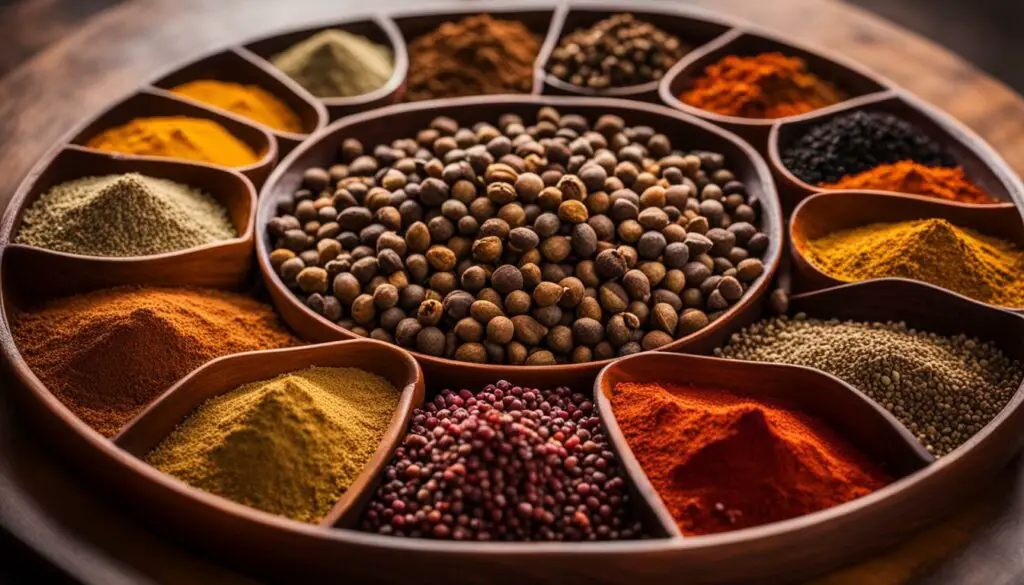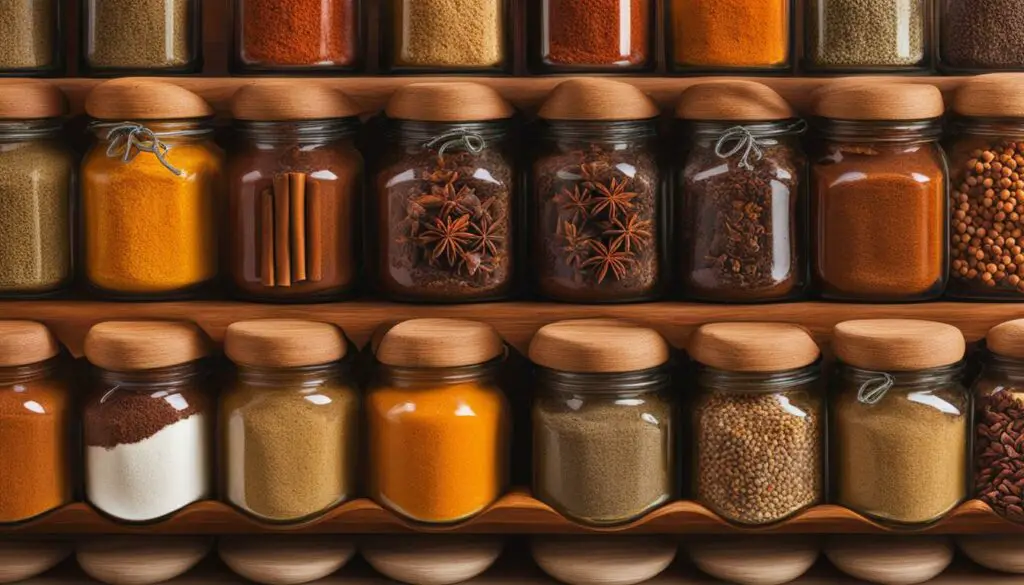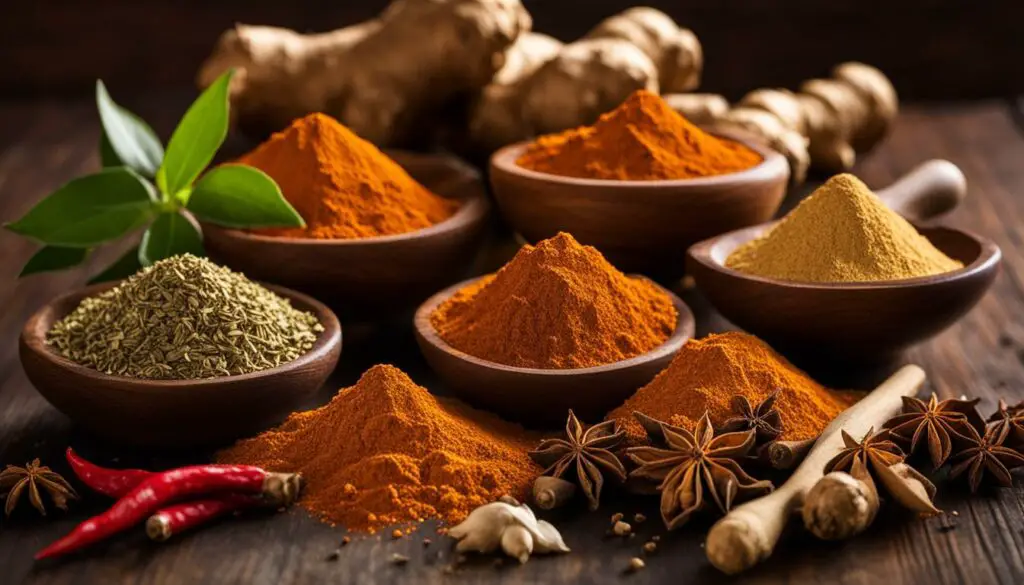Originally posted on November 6, 2023 @ 6:34 am
Spices play a critical role in enhancing the flavor of our dishes, and mace is no exception. Unfortunately, this exotic spice is not always readily available in every kitchen. However, fear not! There are several natural alternatives to mace that can be used as substitutes.
In this section, we will explore various mace substitutes that can easily be found in your spice rack or at your local grocery store. Whether you’re looking for a one-to-one replacement or wanting to experiment with different flavors, we’ve got you covered.
Table of Contents
Key Takeaways:
- There are natural alternatives to mace that can be used to enhance the flavor of your dishes.
- Several common spices, such as nutmeg, allspice, and cloves, can be used as mace substitutes.
- The choice of mace substitute depends on the flavor profile of your dish and personal preference.
- Experimenting with different spice combinations can lead to delightful culinary creations.
- Adjusting recipes when using mace substitutes is essential for maintaining the desired flavor.
Understanding Mace and Its Flavor Profile
If you’re searching for a mace substitute, it’s essential to understand what mace is and how it tastes. Mace is a spice that comes from the outer covering, or aril, of the nutmeg seed. Compared to nutmeg, mace has a more delicate, floral flavor with hints of citrus and pepper.
Although mace is not as commonly used as nutmeg, it’s still an essential spice in various cuisines, including Indian, Middle Eastern, and European dishes.
Mace Spice vs. Nutmeg: What’s the Difference?
While nutmeg and mace come from the same plant, they have distinct differences in flavor. Nutmeg has a warm, nutty, and sweet flavor profile, while mace is more delicate and floral.
Mace is often more expensive than nutmeg since it’s harvested by hand and the arils must be carefully separated from the nutmeg seeds. Therefore, it’s a good idea to have a few mace substitutes on hand, especially if you’re on a tight budget or can’t find mace in your local grocery store.
Mace Seasoning Alternatives
If you’re looking for mace seasoning alternatives, there are plenty of options to choose from. Nutmeg is the closest substitute for mace, but other spices can also provide similar flavor profiles.
Some popular mace substitutes include:
- Allspice: With its warm, peppery flavor, allspice is a versatile alternative to mace.
- Cloves: Often used in baking, cloves can be a suitable replacement for mace, offering a warm and spicy flavor.
- Cardamom: This fragrant spice is perfect for adding depth to both sweet and savory dishes.
- Cinnamon: With its sweet and warm flavor, cinnamon is an excellent choice for mace substitution.
- Ginger: Adding a spicy and aromatic kick to your dishes, ginger can be a versatile option for enhancing your recipes.
When using mace substitutes, it’s essential to keep in mind that each spice has a unique flavor profile and aroma. Therefore, it’s crucial to experiment with different substitutes to find the perfect match for your dishes.
Nutmeg – The Closest Alternative to Mace
If you’re looking for a mace replacement, nutmeg is the closest substitute in terms of flavor. Nutmeg belongs to the same family of spices as mace and is derived from the same fruit. The only difference is that mace comes from the outer covering of the fruit, while nutmeg comes from the inner seed.
When using nutmeg as a substitute, keep in mind that it has a stronger flavor than mace, so use it sparingly. Nutmeg is commonly used in sweet dishes like cakes and pies, but it can also work well in savory dishes like stews and soups.
Using Nutmeg as a Mace Substitute in Recipes
Here are a few recipe ideas that incorporate nutmeg as a mace replacement:
| Recipe | Instructions |
|---|---|
| Apple pie | Use 1/4 teaspoon of nutmeg instead of 1/8 teaspoon of mace to enhance the warm and spicy flavor of the apples. |
| Pumpkin soup | Add a pinch of nutmeg to your pumpkin soup to bring out the earthy and nutty flavors. |
| Beef stew | Use 1/4 teaspoon of nutmeg along with other warm spices like cinnamon and cloves to add depth to your beef stew. |
As you can see, nutmeg can be used in a wide variety of dishes as a mace substitute. Experiment with it in your own recipes to see what delicious results you can create.
Allspice – A Versatile Mace Substitute

Allspice is a common mace substitute that can be used in various dishes. Its warm and peppery flavor is reminiscent of mace, making it an excellent alternative for those seeking a similar taste.
Allspice is commonly used in Caribbean and Middle Eastern cuisine, and it pairs well with meats, vegetables, and desserts. Its versatility makes it an easy ingredient to incorporate into your cooking, whether you’re making a savory stew or a sweet pie.
Using Allspice as a Mace Substitute
Allspice can be used in both whole and ground forms, depending on the recipe. To use whole allspice, crush the berries before adding them to your dish. If using ground allspice, use about half the amount called for in the recipe, as it can be stronger than mace.
Allspice is a great substitute for mace in recipes such as pumpkin pie, where it can provide a warm and spicy flavor. In savory dishes, allspice can be used to add depth to stews, curries, and marinades.
Allspice vs. Mace
While allspice is a popular mace substitute, it does have some differences in flavor. Allspice is warmer and spicier than mace, which has a more delicate, floral flavor. However, the two can be used interchangeably in many recipes, and allspice is an excellent option for those looking for a natural and versatile mace alternative.
| Allspice | Mace |
|---|---|
| Warm and spicy flavor | Delicate, floral flavor |
| Pairs well with meats, vegetables, and desserts | Often used in sweet dishes like pastries and cakes |
| Commonly used in Caribbean and Middle Eastern cuisine | Originates from the nutmeg tree |
Allspice is just one of many mace substitutes available to enhance the flavor of your dishes. Whether you choose allspice, nutmeg, cloves, or another alternative, experimenting with different spices can lead to delightful discoveries in the kitchen.
Cloves – Adding Warmth and Depth to Your Dishes

Cloves are a highly aromatic spice that can add warmth and depth to your dishes. They are an excellent mace substitute for those looking to add a unique flavor to their recipes.
One of the best things about cloves is their versatility. They go well with both sweet and savory dishes, and can be used in a variety of cuisines, from Indian to Middle Eastern to European.
Cloves are commonly used in spice blends like garam masala and pumpkin pie spice, making them a perfect addition to many recipes. They are also a common ingredient in mulled wine and cider.
When using cloves as a mace substitute, it’s important to use them sparingly. They have a strong flavor and can quickly overpower a dish if too much is used. It’s best to start with a small amount and adjust as needed.
How to Use Cloves as a Mace Substitute in Recipes
If you’re looking to use cloves as a mace substitute in your favorite recipes, here are some ideas:
- Add a pinch of ground cloves to your oatmeal or granola for a warm and cozy breakfast
- Use cloves in spice rubs for meats like pork and chicken for an extra burst of flavor
- Add whole cloves to soups and stews for added depth
- Mix cloves with cinnamon and nutmeg for a homemade pumpkin pie spice blend
“Cloves are a great way to add warmth and complexity to your dishes. They have a unique flavor that can elevate your cooking to the next level.”
Keep in mind that cloves have a very strong flavor and can be overpowering if not used in moderation. It’s best to start with a small amount and add more as needed. With a little experimentation, you can find the perfect balance of flavors for your recipes.
Cardamom – A Fragrant and Complex Alternative
If you’re looking for a more complex and fragrant alternative to mace, look no further than cardamom. This spice is native to India, Nepal, and Bhutan and has been used in cooking and traditional medicine for centuries. With its warm and sweet taste, cardamom can be a great substitute for mace in both sweet and savory dishes.
Cardamom pods are the most commonly used form of this spice, though ground cardamom can also be found in many grocery stores. The pods should be crushed to release the small black seeds inside, which can then be ground or used whole in recipes.
When substituting mace with cardamom, start with a small amount and adjust to taste. While both spices share some similarities, cardamom has a slightly more floral and citrusy flavor profile than mace.
Cardamom vs. Mace – Flavor Profile Comparison
| Flavor Profile | Mace | Cardamom |
|---|---|---|
| Sweetness | High | Medium-High |
| Floral | Low | High |
| Citrusy | Low | High |
| Peppery | High | Low |
As shown in the table above, cardamom offers a more balanced flavor profile than mace, with a higher level of sweetness and floral and citrusy notes. However, if you’re looking to add more pepperiness to your dish, mace may be a better option.
Cardamom can be used in a wide variety of dishes, from curries and stews to baked goods and desserts. It pairs particularly well with cinnamon, ginger, and nutmeg, so consider combining these spices for a complex and flavorful blend.
- Use ground cardamom in baked goods, such as cakes and cookies, for a warm and sweet flavor.
- Add whole cardamom pods when simmering rice or grains for an aromatic and fragrant touch.
- Include cardamom in spice blends for Indian and Middle Eastern dishes, such as garam masala or ras el hanout.
When cooking without mace, cardamom can be a versatile and flavorful alternative. Experiment with this spice to see how it can elevate your cooking to the next level!
Cinnamon – A Warm and Sweet Replacement

Cinnamon is a popular spice that can be used as a mace substitute due to its warm and sweet flavor profile. It is an excellent option for baked goods and desserts such as cookies, cakes, and pies. However, when using cinnamon as a mace substitute, it is essential to note that its taste is not as complex as mace.
To use cinnamon as a mace substitute in a recipe, you can use a 1:1 ratio, but keep in mind that cinnamon has a stronger flavor, so you may need to use less of it. For example, if the recipe calls for one tablespoon of mace, you can use one tablespoon of cinnamon, but use only three-fourths of a tablespoon instead.
Difference Between Mace and Cinnamon
While cinnamon can be used as a mace substitute, it is essential to understand its differences. Mace has a more complex and subtle flavor profile, with hints of sweetness, citrus, and pine, while cinnamon has a more straightforward flavor profile with notes of warmth, sweetness, and spiciness. It is, therefore, necessary to adjust the recipe accordingly when you substitute mace with cinnamon.
Here is a table that shows the differences between mace and cinnamon:
| Flavor Profile | Mace | Cinnamon |
|---|---|---|
| Sweetness | High | Moderate |
| Warmth | Moderate | High |
| Spiciness | Mild | High |
| Citrus | High | Low |
| Pine | Moderate | Low |
Overall, cinnamon is an excellent choice as a mace substitute, especially in baked goods and desserts. Its warm and sweet flavor profile adds depth to any recipe, making it a versatile spice in your kitchen. Just remember to adjust the amount of cinnamon you use according to your recipe, and you’ll be on your way to creating delicious dishes without mace.
Ginger – Adding a Spicy Kick to Your Dishes

If you’re looking for a mace substitute that can add a spicy kick to your dishes, ginger is an excellent option.
Ginger has long been used in Asian cuisine and is a staple in dishes such as stir-fries and curries. It has a distinctive flavor that is both spicy and slightly sweet, making it a versatile spice that can be used in both sweet and savory recipes.
When using ginger as a mace substitute, it’s essential to keep in mind that it has a more pungent flavor than mace. Therefore, you’ll need to adjust the quantity depending on the recipe’s flavor profile.
One of the most significant benefits of using ginger as a mace substitute is its health benefits. Ginger is known for its anti-inflammatory and antioxidant properties and can help improve digestion and relieve nausea.
To add ginger to your recipes, you can use fresh ginger root, ground ginger, or ginger paste. Fresh ginger root will provide the most flavor, but ground ginger and ginger paste are more convenient options.
Whether you’re making a spicy stir-fry or a sweet dessert, ginger is a fantastic mace substitute that can add depth and complexity to your dishes.
Other Spices and Combinations to Consider
Aside from the mace substitutes we discussed earlier, there are other spices and combinations you can try in your cooking. Here are a few options to consider:
| Spice | Flavor Profile | Best Used In |
|---|---|---|
| Paprika | Warm, Smoky | Meat dishes, Soups, Stews |
| Pumpkin Pie Spice | Sweet, Spicy | Baked goods, Sweet Potatoes |
| Star Anise | Licorice, Sweet | Asian dishes, Meat marinades |
Keep in mind that these spices and combinations will not be an exact match for mace, but they can provide a similar flavor profile. Don’t be afraid to experiment with different spices and combinations to find what works best for your recipes.
As always, when using a new spice or substitute, start with a small amount and adjust to taste.
Whether you’re cooking with nutmeg, allspice, cloves, or any of the other spices we’ve discussed, each can bring a unique flavor profile to your dishes.
Up next, we’ll explore how you can use these mace substitutes in different cuisines.
Using Mace Substitutes in Different Cuisines
When it comes to using mace substitutes in different cuisines, the possibilities are endless! Different cultures use an array of spices to enhance flavor profiles, so it’s essential to consider the cuisine you’re cooking and its traditional spice blends.
Middle Eastern Cuisine: Middle Eastern dishes often use warm and savory spices, such as cumin, coriander, and cinnamon. Swap out mace for cinnamon or allspice in dishes like shakshuka or tagine for a warm and comforting flavor.
Indian Cuisine: Indian curries and spice blends use a unique combination of spices, including cardamom, cloves, and ginger. Substitute mace with any of these spices or create your blend of garam masala for an authentic flavor.
European Cuisine: European cuisine often features nutmeg in dishes like potato gratin, spinach quiche, and pumpkin soup, making it a seamless substitution for mace. Other options include allspice and cinnamon for sweet and savory dishes.
Mace Substitute Table
| Mace Substitute | Flavor Profile | Best Used In |
|---|---|---|
| Nutmeg | Warm and nutty | Potato dishes, cream sauces, baked goods |
| Allspice | Warm and peppery | Middle Eastern dishes, meats, stews |
| Cloves | Warm and sweet | Baked goods, marinades, roasts |
| Cardamom | Fragrant and complex | Chai tea, desserts, marinades |
| Cinnamon | Warm and sweet | Baked goods, oatmeal, Middle Eastern dishes |
| Ginger | Spicy and aromatic | Baked goods, Asian dishes, savory marinades |
Explore different mace substitutes and experiment with various cuisines to find the perfect replacement for your recipes. Remember to adjust the amount and combinations of spices to balance the flavors, creating a delicious and unique dish every time.
Tips for Adjusting Recipes with Mace Substitutes
When using mace substitutes in recipes, it’s essential to adjust other ingredients as well, to ensure that the final dish has the desired flavor and aroma. Here are some tips to help you get started:
- Start with a small amount: When trying out a new mace substitute, start with a small amount and gradually increase it until you achieve the desired flavor.
- Consider the flavor profile: Since each mace substitute has a distinct flavor profile, consider how it might affect the other ingredients in your recipe.
- Experiment with combinations: Don’t be afraid to experiment with different spice combinations to find what works best for your recipe. For instance, you might try using a blend of cinnamon and nutmeg as a substitute for mace.
- Adjust the cooking time: Some mace substitutes may require less cooking time than others, so be sure to adjust accordingly.
Remember, substituting mace with other spices can be a fun and creative way to add new flavors to your cooking. So don’t be afraid to experiment and try new things!
Conclusion
Experimenting with mace substitutes can be an exciting and rewarding experience for any home cook. By understanding the unique flavor profile of mace and its substitutes, you can elevate your dishes to new heights.
While nutmeg is often considered the closest alternative to mace, options such as allspice, cloves, cinnamon, ginger, and cardamom can offer distinct and complex flavors to your recipes.
It’s important to keep in mind that adjusting recipes when using mace substitutes may be necessary. However, with a little experimentation and some helpful tips, such as using less of a substitute or combining spices, you can achieve your desired flavor.
Don’t be afraid to get creative!
Consider trying other spice combinations, such as pumpkin pie spice or garam masala, to see what unique flavors they can add to your dishes. And don’t forget to incorporate mace substitutes into different cuisines, from Indian curries to Middle Eastern stews.
Ultimately, the key to using mace substitutes is to have fun and explore new flavor profiles. So go ahead and stock your spice rack with a variety of options, and get ready to impress your taste buds and dinner guests alike.
FAQ
What is mace?
Mace is a spice derived from the dried outer covering of the nutmeg seed. It has a slightly sweeter and more delicate flavor compared to nutmeg.
Why would I need a mace substitute?
Mace may not be readily available in your pantry, or you may be looking for a different flavor profile. Substituting mace can help you achieve similar taste results in your recipes.
What is the closest alternative to mace?
Nutmeg is often considered the best substitute for mace due to its similar flavor profile. You can use nutmeg as a replacement in your recipes.
How can I use allspice as a mace substitute?
Allspice offers a versatile alternative to mace, with its warm and peppery flavor. You can use allspice to achieve a similar taste in your dishes by using it in the same quantities as mace.
Can cloves be used as a mace substitute?
Yes, cloves can be used as a mace substitute. They add a distinct flavor profile to your recipes, enhancing warmth and depth in dishes.
How can I use cardamom as a mace substitute?
Cardamom offers a fragrant and complex alternative to mace. It can be incorporated into both savory and sweet recipes to add depth and complexity to your dishes.
Can cinnamon be used as a mace substitute?
Yes, cinnamon can be used as a mace substitute. It provides a warm and sweet flavor to your dishes and can be used in a similar quantity as mace.
How can ginger be used as a mace substitute?
Ginger adds a spicy and aromatic kick to your dishes, making it a suitable mace substitute. Use ginger in the same quantities as mace to achieve similar flavor results.
Are there any other spices that can be used as mace substitutes?
Yes, there are several other spices and combinations that can be used as mace substitutes. Some options include paprika, pumpkin pie spice, and other warm and aromatic spices.
Can mace substitutes be used in different cuisines?
Absolutely! Mace substitutes can be used in various cuisines, including Indian, Middle Eastern, and European dishes. Experimenting with different substitutes can add unique flavors to your culinary creations.
How should I adjust recipes when using mace substitutes?
When using mace substitutes, it’s important to adjust the quantities to maintain the desired flavor. Start with smaller amounts of the substitute and gradually adjust according to your taste preferences.
See also:
Leave a Reply